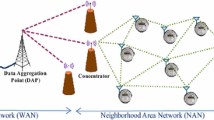Abstract
Driven by the need to improve energy efficiency and reduce environmental impact, we observe a thrust towards enabling a Smart Grid. It is envisaged that to achieve these goals, the Smart Grid will be equipped with communications infrastructure and mechanisms that will enable near real-time control of the grid components. One of the key elements of the Smart Grid is the advanced metering infrastructure (AMI) which is expected to facilitate the transport of meter readings from a smart electricity meter at the customer premises to the utility provider, and control data in the other direction. These communications can be potentially realized by deploying a self-organizing mesh network composed of smart metering nodes connected to concentrator nodes which in turn are connected to the utility provider data management systems. This paper explores a cooperative communications approach to improve reliability of such mesh networks. The proposed opportunistic forwarding protocol called ‘ORPL’ has been realized as an enhancement on top of the routing protocol for low power and lossy networks, a connectivity enabling mechanism in AMI mesh networks. In ORPL, smart meter nodes select multiple candidate relays to facilitate reliable transport of smart metering data to the concentrator node. Moreover, it is designed to work in a distributed manner thereby ensuring scalability. We also present a further extension to ORPL, i.e., ORPLx with adaptive medium access control retransmit limit, which reduces unnecessary retransmissions. Our protocols have been evaluated and verified with comprehensive experimental results, demonstrating their effectiveness and favorable characteristics.















Similar content being viewed by others
Notes
Wireless medium is a broadcast medium, therefore it is possible to design protocols that make use of this to improve link reliability.
Objective function in RPL protocol is used to calculate the rank of each node relative to the sink node in terms of a chosen link quality metric such as ETX or RSSI [21].
\(RSSI_{avg}=\alpha \times RSSI_{current} + (1-\alpha) \times RSSI_{avg}, \alpha = 0.25.\)
Rime is a lightweight communication stack designed for low-power radios.
i.e., one initial transmission and \(k-1\) retransmissions.
But, this approach is not very accurate due to interference effects and dynamic nature of wireless channel.
For a particular transmit power level.
\(RSSI_{avg}=\alpha \times RSSI_{current} + (1-\alpha ) \times RSSI_{avg}, \alpha = 0.25\)
Each node has a unique ID.
References
Balanis, C. A. (2005). Antenna theory: Analysis and design (3rd ed.). New York: Wiley.
Biswas, S., & Morris, R. (2004). Opportunistic routing in multi-hop wireless networks. ACM SIGCOMM Computer Communication Review, 34(1), 69–74. doi:10.1145/972374.972387.
Chen, C., Lin, C., & Chen, Y. (2010). Cross-layer packet retry limit adaptation for video transport over wireless LANs. IEEE Transactions on Circuits and Systems for Video Technology, 20(11), 1448–1461.
Choudhury, R., & Vaidya, N. (2004). MAC-layer anycasting in ad hoc networks. ACM SIGCOMM Computer Communication Review, 34(1), 75–80.
Contiki. (2010). The operating system for connecting the next billion devices: The Internet of Things. http://www.sics.se/contiki/.
Couto, D., Aguayo, D., Bicket, J., & Morris, R. (2003). A high-throughput path metric for multi-hop wireless routing. In ACM MOBICOM.
Duquennoy, S., & Landsiedel, O. (2013). Poster abstract: Opportunistic RPL. In Proceedings of the 10th European conference on wireless sensor networks.
Fan, Z., Kulkarni, P., Gormus, S., Efthymiou, C., Kalogridis, G., & Sooriyabandara, M., et al. (2013). Smard grid communications: Overview of research challenges, solutions, and standardization activities. IEEE Communications Surveys and Tutorials, 15, 21–38.
Gormus, S., & Bocus, M.Z. (2013). Efficient cooperative anycasting for AMI mesh networks. In 10th IEEE global communications conference, Atlanta, GA.
Gormus, S., Fan, Z., Bocus, Z., & Kulkarni, P. (2011). Opportunistic communications to improve reliability of AMI mesh networks. In IEEE innovative Smart Grid technologies Europe (ISGT EU) conference, Manchester.
Iwao, T., Yamada, K., Yura, M., Nakaya, Y., Cardenas, A., Lee, S., & Masuoka, R. (2010). Dynamic data forwarding in wireless mesh networks. In IEEE Smart Grid communications conference, Gaithersburg, MD.
Iyer, G., Agrawal, P., Monnerie, E., & Salazar, R. (2011). Performance analysis of wireless mesh routing protocols for smart utility networks. In IEEE Smart Grid communications conference, Brussels, Belgium.
Kulkarni, P., Gormus, S., Fan, Z., & Motz, B. (2012). A mesh-radio-based solution for smart metering networks. IEEE Communications Magazine, 50(7), 86–95.
Laneman, J. N., Wornell, G. W., & Tse, D. N. C. (2001). An efficient protocol for realizing cooperative diversity in wireless networks. In IEEE international symposium on information theory (ISIT).
Li, Q., & van der Schaar, M. (2004). Providing adaptive QoS to layered video over wireless local area networks through real-time retry limit adaptation. IEEE Transactions on Multimedia, 6(2), 278–290.
Lichtensteiger, B., Bjelajac, B., Muller, C., & Wietfeld, C. (2010). RF mesh systems for smart metering: System architecture and performance. In IEEE Smart Grid communications conference, Gaithersburg, MD.
Pavkovic, B., Theoleyre, F., & Duda, A. (2011). Multipath opportunistic RPL routing over IEEE 802.15.4. In ACM International conference on modeling, analysis and simulation of wireless and mobile systems, Miami Beach, FL.
Schaefer, G., Ingelrest, F., & Vetterli, M. (2009). Potentials of opportunistic routing in energy-constrained wireless sensor networks. In European conference on wireless sensor networks.
Srinivasany, K., Jainy, M., Choiy, J.I., & Azim, T. (2010). The k Factor: Inferring protocol performance using inter-link reception correlation. In In the proceedings of the 16th annual international conference on mobile computing and networking.
TELOSB Mote Platform. (2010). http://www.willow.co.uk/html/telosb_mote_platform.html.
Winter, T., & Thubert, P., et al. (2012). RPL: IPv6 routing protocol for low power and lossy networks, RFC 6550. IETF ROLL WG: Tech. rep.
Wolsey, L. (1998). Integer programming (1st ed.). New York: Wiley.
Author information
Authors and Affiliations
Corresponding author
Rights and permissions
About this article
Cite this article
Gormus, S., Tosato, F., Fan, Z. et al. Opportunistic RPL for reliable AMI mesh networks. Wireless Netw 20, 2147–2164 (2014). https://doi.org/10.1007/s11276-014-0730-1
Published:
Issue Date:
DOI: https://doi.org/10.1007/s11276-014-0730-1




